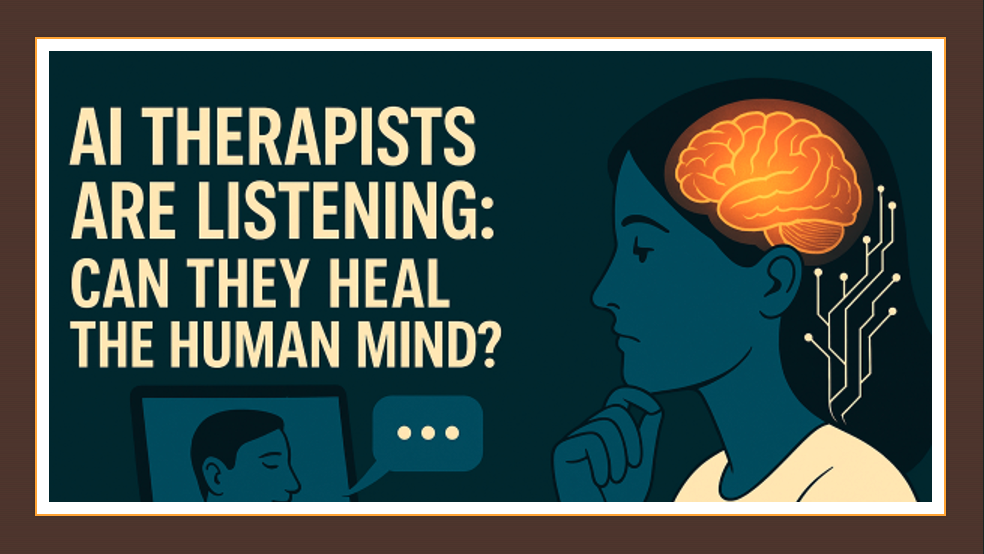AI Therapists Are Listening: Can They Heal the Human Mind?
Can machines genuinely understand and—heal — the human mind?
In an era where algorithms diagnose diseases, manage investments, and even compose music, it was only a matter of time before artificial intelligence stepped into the most intimate corners of the human experience: our thoughts, traumas, and emotional well-being.
Enter AI therapists. These digital mental health companions, powered by machine learning and natural language processing, promise 24/7 support, zero judgment, and an uncanny ability to remember everything you’ve ever said. But beneath the surface of convenience lies a profound and controversial question: Can machines genuinely understand — and heal — the human mind?
A New Age of Therapy: Hope or Hype?
Apps like Woebot, Wysa, and Replika have already carved out a space in the digital mental health marketplace. With a few taps, users can converse with a chatbot designed to simulate the empathetic guidance of a human therapist. These AI systems are trained on cognitive behavioural therapy (CBT) principles, allowing them to guide users through reframing negative thoughts, practising mindfulness, or even managing panic attacks.
To many, the appeal is obvious. Traditional therapy can be expensive, difficult to access, and still stigmatized in many cultures. AI therapists, in contrast, are available on demand, often free, and can offer anonymity. A chatbot might be the only option for someone in crisis at 2 a.m.
Yet, the question remains — are these tools helping people heal, or are they simply a digital Band-Aid for a deeper mental health epidemic?
The Illusion of Empathy: Can Machines Truly Understand Pain?
One of the cornerstones of effective therapy is empathy — the ability to feel with another person, to mirror their emotional state, and to respond with compassion. While AI can simulate empathy through carefully curated language models, it lacks the fundamental human experiences that give empathy its authenticity.
A therapist doesn’t just listen; they interpret body language, tone, pauses, and tears. They bring their own lived experiences to the conversation. A machine, no matter how advanced, lacks this intuitive, emotional intelligence.
And yet, some users report feeling heard and validated by their AI therapists. Is it possible that in some cases, the perception of empathy is enough to produce real psychological benefit? Could the placebo effect be at play — or does the act of journaling one’s thoughts into a machine trigger a cognitive shift regardless of the source?
Data, Ethics, and the Danger of Emotional Surveillance
Let’s address the elephant in the room: privacy.
AI therapists rely on vast datasets to learn, improve, and personalize responses. That means every thought you share — from self-doubt to suicidal ideation — becomes data. Who owns that data? How is it stored? What happens if it’s breached or sold?
The concept of "emotional surveillance" is unsettling. Imagine your most vulnerable moments being harvested for training algorithms or, worse, monetized for targeted advertising. While many apps claim to be secure and confidential, the truth is, that most lack the oversight and regulation of licensed mental health practices.
This raises another ethical dilemma: Should we allow machines to take on roles of such psychological intimacy without clear, enforceable standards? Should there be a "digital Hippocratic oath" for AI therapists?
The Human-AI Hybrid Model: A Promising Middle Ground
While full autonomy in therapy may not yet be achievable — or advisable — AI can play a powerful assistive role. Many therapists are beginning to incorporate AI tools into their practice to monitor patient progress, detect patterns, and even flag signs of crisis that might otherwise go unnoticed.
Think of it not as a replacement, but as an augmentation. An AI might track micro-shifts in mood over time through journal entries or voice patterns and alert a human therapist. It could help patients stay engaged between sessions through reminders, breathing exercises, or guided reflections.
The best outcomes might emerge not from man or machine, but from a collaboration between the two.
Mental Health for the Masses: Democratizing Therapy Through AI
In a world where more than 1 billion people experience mental health challenges — and the vast majority have no access to care — AI offers a tantalizing vision of scaled support. A virtual therapist doesn’t sleep, doesn’t burn out, and can potentially serve millions simultaneously.
For underserved communities, war-torn regions, or areas with a scarcity of mental health professionals, AI therapists could offer a lifeline. In this context, even imperfect help is better than no help at all.
But as we rush to scale these solutions, we must ask: Are we treating people’s pain with genuine care, or simply optimizing it for efficiency?
The Soul Question: What Makes Healing Human?
At the heart of the debate is a deeper philosophical tension. Can healing be reduced to code? Is there something sacred — and inherently human — about being truly seen and understood by another person? Some would argue that our mental wounds aren’t just misfiring neurons or distorted thought patterns, but complex tapestries of memory, culture, trauma, and identity. These cannot be parsed by an algorithm trained solely on clinical textbooks and Reddit threads.
Others counter that if AI can learn to replicate the mechanics of healing — identify irrational thoughts, reinforce positive behaviours, and offer emotional support — then why not embrace it?
The answer, perhaps, lies in redefining what we expect from therapy. Is it about being fixed? Or is it about feeling safe, understood, and supported?

